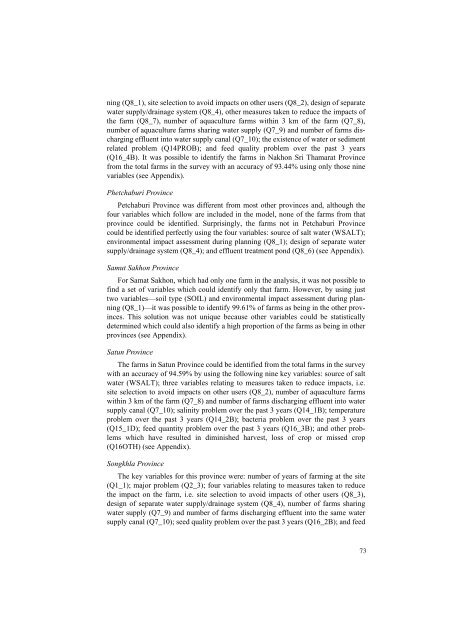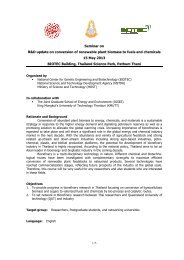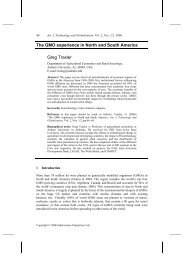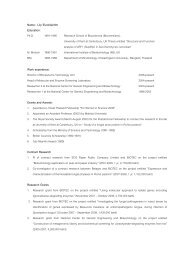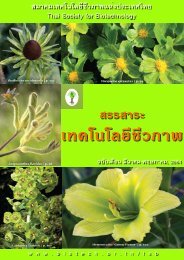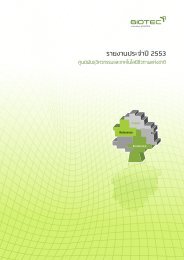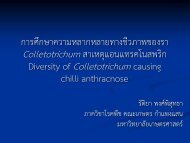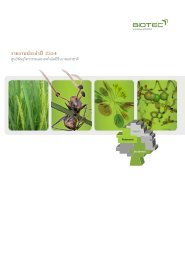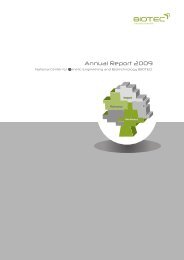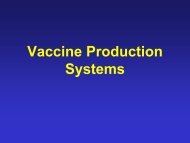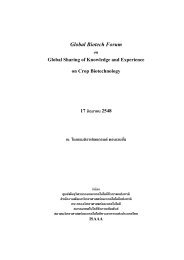Coastal Shrimp Aquaculture in Thailand: Key Issues for Research
Coastal Shrimp Aquaculture in Thailand: Key Issues for Research
Coastal Shrimp Aquaculture in Thailand: Key Issues for Research
You also want an ePaper? Increase the reach of your titles
YUMPU automatically turns print PDFs into web optimized ePapers that Google loves.
!n<strong>in</strong>g (Q8_1), site selection to avoid impacts on other users (Q8_2), design of separatewater supply/dra<strong>in</strong>age system (Q8_4), other measures taken to reduce the impacts ofthe farm (Q8_7), number of aquaculture farms with<strong>in</strong> 3 km of the farm (Q7_8),number of aquaculture farms shar<strong>in</strong>g water supply (Q7_9) and number of farms discharg<strong>in</strong>geffluent <strong>in</strong>to water supply canal (Q7_10); the existence of water or sedimentrelated problem (Q14PROB); and feed quality problem over the past 3 years(Q16_4B). It was possible to identify the farms <strong>in</strong> Nakhon Sri Thamarat Prov<strong>in</strong>cefrom the total farms <strong>in</strong> the survey with an accuracy of 93.44% us<strong>in</strong>g only those n<strong>in</strong>evariables (see Appendix).Phetchaburi Prov<strong>in</strong>cePetchaburi Prov<strong>in</strong>ce was different from most other prov<strong>in</strong>ces and, although thefour variables which follow are <strong>in</strong>cluded <strong>in</strong> the model, none of the farms from thatprov<strong>in</strong>ce could be identified. Surpris<strong>in</strong>gly, the farms not <strong>in</strong> Petchaburi Prov<strong>in</strong>cecould be identified perfectly us<strong>in</strong>g the four variables: source of salt water (WSALT);environmental impact assessment dur<strong>in</strong>g plann<strong>in</strong>g (Q8_1); design of separate watersupply/dra<strong>in</strong>age system (Q8_4); and effluent treatment pond (Q8_6) (see Appendix).Samut Sakhon Prov<strong>in</strong>ceFor Samat Sakhon, which had only one farm <strong>in</strong> the analysis, it was not possible tof<strong>in</strong>d a set of variables which could identify only that farm. However, by us<strong>in</strong>g justtwo variables—soil type (SOIL) and environmental impact assessment dur<strong>in</strong>g plann<strong>in</strong>g(Q8_1)—it was possible to identify 99.61% of farms as be<strong>in</strong>g <strong>in</strong> the other prov<strong>in</strong>ces.This solution was not unique because other variables could be statisticallydeterm<strong>in</strong>ed which could also identify a high proportion of the farms as be<strong>in</strong>g <strong>in</strong> otherprov<strong>in</strong>ces (see Appendix).Satun Prov<strong>in</strong>ceThe farms <strong>in</strong> Satun Prov<strong>in</strong>ce could be identified from the total farms <strong>in</strong> the surveywith an accuracy of 94.59% by us<strong>in</strong>g the follow<strong>in</strong>g n<strong>in</strong>e key variables: source of saltwater (WSALT); three variables relat<strong>in</strong>g to measures taken to reduce impacts, i.e.site selection to avoid impacts on other users (Q8_2), number of aquaculture farmswith<strong>in</strong> 3 km of the farm (Q7_8) and number of farms discharg<strong>in</strong>g effluent <strong>in</strong>to watersupply canal (Q7_10); sal<strong>in</strong>ity problem over the past 3 years (Q14_1B); temperatureproblem over the past 3 years (Q14_2B); bacteria problem over the past 3 years(Q15_1D); feed quantity problem over the past 3 years (Q16_3B); and other problemswhich have resulted <strong>in</strong> dim<strong>in</strong>ished harvest, loss of crop or missed crop(Q16OTH) (see Appendix).Songkhla Prov<strong>in</strong>ceThe key variables <strong>for</strong> this prov<strong>in</strong>ce were: number of years of farm<strong>in</strong>g at the site(Q1_1); major problem (Q2_3); four variables relat<strong>in</strong>g to measures taken to reducethe impact on the farm, i.e. site selection to avoid impacts of other users (Q8_3),design of separate water supply/dra<strong>in</strong>age system (Q8_4), number of farms shar<strong>in</strong>gwater supply (Q7_9) and number of farms discharg<strong>in</strong>g effluent <strong>in</strong>to the same watersupply canal (Q7_10); seed quality problem over the past 3 years (Q16_2B); and feed&"


